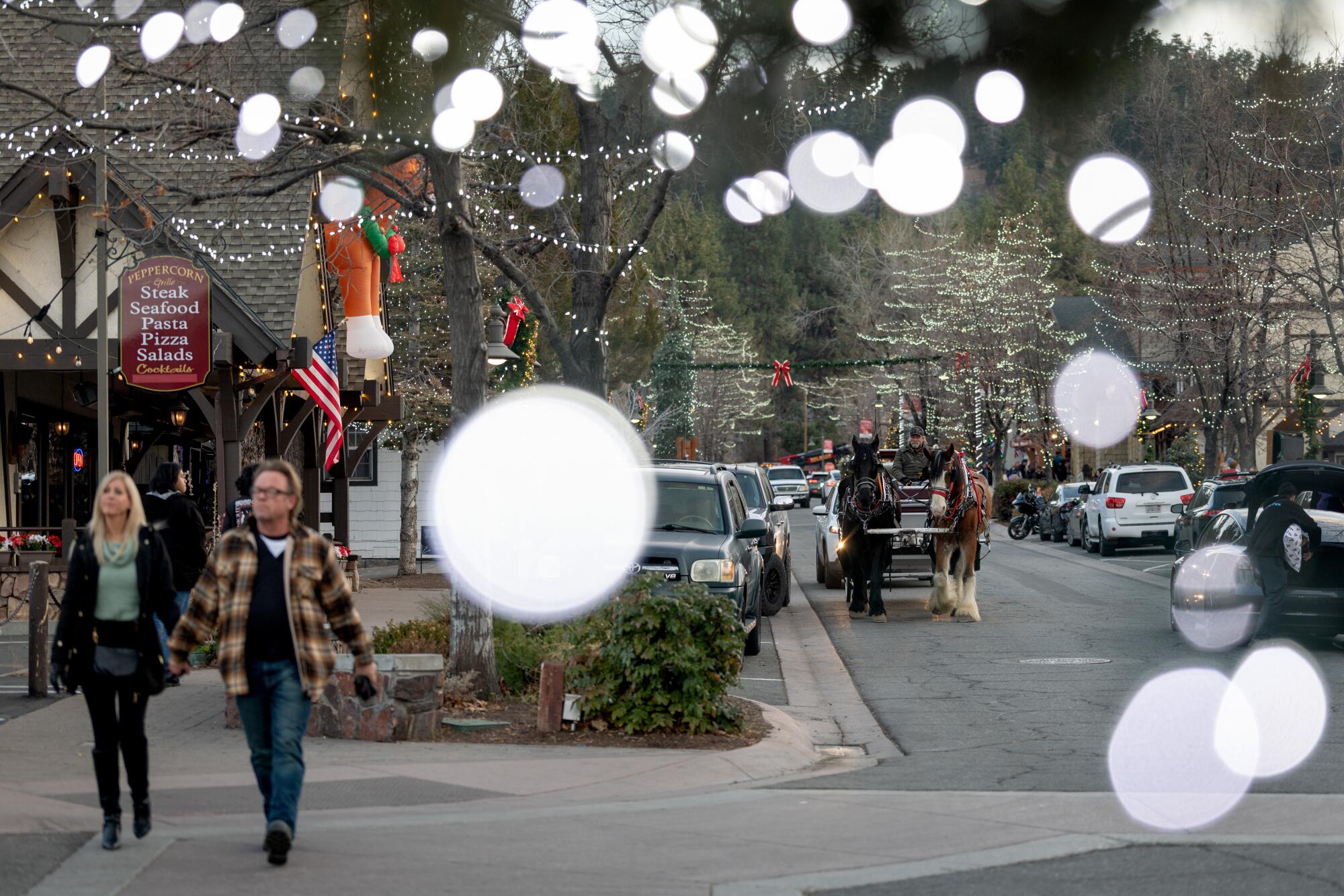Will the coming storm save California’s ski season?
Nothing but dirt and dry, brown chaparral rolled beneath skis and snowboards dangling from a chairlift at Big Bear Mountain Resort on Friday, as forlorn adventure seekers joked they should rename the place “Big Bare.”
Unseasonably high temperatures even left the impressive array of high-tech artificial-snow makers below mostly useless, their fans spinning idly in the warm breeze.
“The word I’ve been using is “abysmal,” said Cameron Miniutti, 29, who was riding the lift in a light cotton shirt, with the hot sun glinting off his ski goggles. “This is, for sure, the toughest start [to a season] I’ve seen.”
Similarly bleak panoramas can be found at ski areas across the American West so far this year, but especially in California, where a wet November gave way to one of the driest Decembers in recent memory.

People visit Big Bear Village on Sunday, with no snow in sight.
As of Friday, the state had only 12% of the snow that’s normal for this time of year, and only 3% of what water managers hope for in an average year, according to the California Department of Water Resources.
Which is why water managers — and skiers — are hoping for a Christmas miracle as an enormous atmospheric river takes aim at California this week. The soaking rains may threaten coastal cities with flash floods and nightmarish traffic, but they promise sweet relief for snow-starved thrill seekers from Lake Tahoe to the San Bernardino Mountains in Southern California.
Mammoth Mountain, the tallest commercial ski resort in California, could get up to 7 feet of snow this week, according to On the Snow, a website that tracks conditions at ski areas.
Resorts on the north end of Lake Tahoe could see up to 5 feet, and even Big Bear could get 3 feet, assuming the temperature stays below freezing, according to the website.
That’s important to everyone, even nonskiers, because roughly a third of the water California relies on each year for drinking, farming and fighting wildfires accumulates as snow in the mountains during the winter and then gradually melts through the spring and summer, when the state can otherwise be bone dry.
Many California ski areas were forced to delay opening this year, and even those that got the lifts spinning have had to confine skiers to only a handful of runs, often on man-made snow.
That has been this case at Big Bear, where a thin strip of artificial snow snakes from the 8,440 top of the Bear Mountain Express chairlift to the base at just over 7,000 feet. While crews worked diligently to rake the fake snow over exposed rocks and patches of bare dirt on Friday, skiers and boarders scraped by like traffic on the 405 Freeway.
“It’s crazy,” Miniutti said, “I mean, I can’t even imagine what this is like on a weekend.”
And the range of abilities of people crammed onto the same run creates its own, unique kind of “obstacle course,” Miniutti said.
You have to concentrate on not crashing into people in front of you — many of whom are absolute beginners, tumbling to the snow for no apparent reason — while praying the very good skiers and snowboarders you can hear racing up behind you will somehow avoid mowing you down.

People ski and snowboard at Big Bear Mountain Resort on man-made snow on Sunday.
“There’s, like, the best snowboarders in the world and people on their first day right next to each other,” Miniutti said.
But under the circumstances, Miniutti had nothing but admiration for the mountain staff for keeping the run open despite the seemingly impossible weather.
“I’m still having a blast,” he said, “it’s absolutely worth coming up.”
Devon James, 24, from Pasadena, felt the same way. He was warm in long sleeves, which he took to wearing after wiping out in short sleeves a week ago and “getting cut up.”
One day lift tickets at Big Bear cost more than $150 this season. At fancier resorts, like Mammoth Mountain, they can easily climb to more than $200 per day. So most serious skiers buy season passes for just under $1,000 that are good at many mountains across the country and around the world.
But that means they feel compelled to get their days in, no matter the conditions.
“I mean, that’s kind of the whole game, right,” James laughed. “I’ve got to get at least eight or nine days to get back to even.”

Skiers and snowboarders navigate bare areas at Big Bear Mountain Resort.
Miniutti, who is originally from Massachusetts, and learned to snowboard on the freezing, icy hills of New England, still prefers the alpine experience on the West Coast.
Even when there are legitimate winter conditions at Big Bear, he loves hopping in his car at the end of the day and driving home to Los Angeles, where it’s seemingly always 70 degrees and sunny.
“I can’t really beat that,” he said, “I’m not complaining.”
